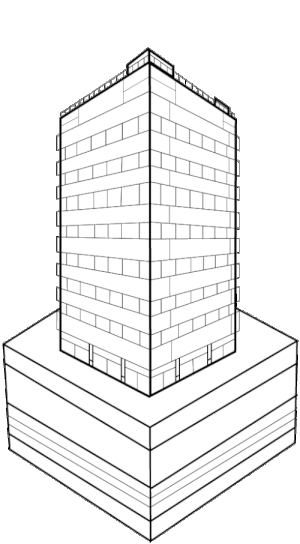The same helical piers that are used to stabilize and lift the foundations of buildings that have settled or experienced foundational shifts can — and should — be used in pre-construction situations as well. Buildings being constructed in sinkhole-prone areas or areas that may potentially shift over time can have helical piers installed prior to the building’s construction to ward off any potential hazards in the future. Doing so works as an insurance policy, helping save thousands of dollars in repair expenses should a shift occur.
Advantages of Helical Piers

Helical piers can be used to resist both uplift and compression loads when installed to proper depth and torque. The helix plates serve as individual elements to support a load.
Advantages include:
– Hydraulically driven
– Non-invasive
– Fast installation
– Immediate load-bearing
– Limited excavating
– Unlimited depth
About Pre-Construction Helical Piers
Pre-construction helical piers have three main sections:
1. Pre-construction bracket
2. Pre-construction helical pipe
3. Helical lead section
PRE-CONSTRUCTION BRACKET
A pre-construction bracket can be ordered in a variety of sizes. Square seats, made of ¾-inch steel, are available in 6- to 16-inch sizes with four support gussets for added structural support space. The top seat can even be ordered with pre-drilled holes for foundation rebar tie-in.
PRE-CONSTRUCTION HELICAL PIPE
This helical pipe is available in either 2.875-inch or 3.5-inch outside diameter (OD) with Schedule 80 P110 grade. The pipe is threaded with a triple-start thread for ease of installation and can be hot-dipped galvanized, when necessary, to ASTM A-153 standards, ensuring decades of rust and corrosion resistance.
HELICAL LEAD SECTION
As a result of their true helical shape, the helices do not auger into the soil but rather screw into it with minimal disturbance. The first section, called the Lead Section, contains the helical plates. The Lead Section can consist of one to four helices.
If required, additional helices can be added with the use of helical extensions. Plain extensions are then added until the Lead Section penetrates the bearing strata and the necessary or appropriate torque is achieved.
How To Use Helical Piers During Pre-Construction
The best time to install helical piers for pre-construction situations is before pouring footings or installing the foundation of a structure. First, hydraulically drill past the soft soil, into the harder strata, for better stability. An engineer should take into consideration the weight of the structure that will be placed onto the piers in order to calculate the location and number of piers necessary to support the structure. They’ll also need to determine the torque installation for each pier.
Once the specifics like location and depth have been decided, the driving begins. The lead helical section, composed of a steel pipe with multiple plates ranging from 8-16 inches in diameter, should be connected to a hydraulic drive assembly and drilled into the ground. After the lead helical section is driven, add the helical extensions and continue drilling until the helical is securely in place at the pre-determined depth.
During drilling, it is best to use a torque indicator that continuously monitors each pier and confirms the proper stability. At Helicon, we use a torque indicator that transfers the data securely to a mobile device for easy, constant monitoring no matter the location.
When the piers are installed, they should be capped and then installed into the foundation of the structure, providing foundation stability and safeguarding against future shifts.
Recent Helical Pile project completed by Helicon
Helicon recently installed pre-construction helical piers at The Collective in Naples, Florida, partnering with DeAngelis Diamond and Universal Engineering Sciences. Over the course of approximately three months, they drilled 226 galvanized helical piers to an average depth of 25 feet. The piers were installed before the building’s foundation in order to give it better stability in an area prone to sinkholes. To learn more about the project, visit www.helicon.usa/projects.